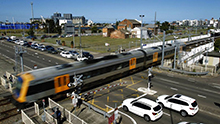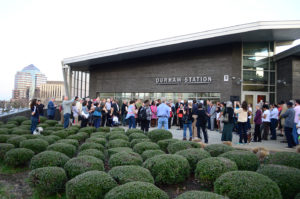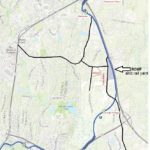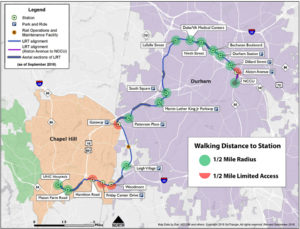Light Rail (DOLRT) Does not Protect Our Environment
If we expected this rail project to draw a large ridership and the route connected with RDU or RTP, then people would get out of their cars and on to transit, and this project would be far more efficient and desirable. However, because the route is problematic, and is not located where most people are traveling between Orange and Durham, auto emissions will not be reduced. GoTriangle’s own Environmental Impact Statement makes no such claim. If energy use and emissions are not reduced, this project hurts rather than helps our goal of mitigating global warming.
1. The DOLRT has incidental impact on improved energy use.
GoTriangle’s Environmental Impact Statement (EIS) estimates annual transportation energy use in the Triangle region, including cars and all forms of public transit, both for the no build alternative (no light rail) and with light rail in operation. Light rail is estimated to reduce annual transportation energy consumption by 83 billion British Thermal Units. This sounds like a lot, but it is less than a one tenth of one percent reduction. For such a long range and complex estimate, this is insignificant and meaningless. The EIS also estimates indirect energy consumption, the amount of energy used to manufacture materials and construct the light rail system. This indirect use amounts to 37 times the estimated annual energy conservation. So if the EIS is correct, it will take 37 years for the tiny annual energy savings to total the energy used for construction of the project.
2. The DOLRT does not reduce traffic congestion.
The many at grade crossings will hold up traffic many times a day. The EIS studied a number of intersections near the track to see how the level of service ratings would be affected. In a number of cases the LOS goes down a grade or so, say from C to D.
Beyond the limited issue of the effects of the at grade crossings, however, the EIS does not address what quantitative effect light rail will have on major regional roads. Would the light rail project reduce congestion on 15-501 between Chapel Hill and Durham? This road would presumably be the most likely to benefit. But the EIS provides no information to support congestion relief on 15-501 or any other thoroughfare. Note: the Blue Hill 2030 mobility study does identify the reduction at 7%.
3. The DOLRT does not improve air quality.
The EIS contains no data, calculations, or modeling related to significant air quality parameters in the region or in the rail corridor. The EIS provides no basis to claim that light rail will improve air quality.
The light rail project plans over 40 at-grade street crossings [details], which will leave cars stopped and idling while the trains pass. There is a special federal requirement to estimate any increase in carbon emissions, which could contribute to climate change.
4. What are the noise impacts? Neighborhoods near the DOLRT should be very concerned that a train horn will sound at grade crossings every 10 minutes, not to mention track noise from the trains. Click here for more information about the significant noise pollution that will be created by the DOLRT.
5. Does DOLRT reduce sprawl?
This is a claim that the some proponents have made in public hearings. It’s true that often a fixed rail line will draw density because businesses and residents find it convenient to live near public transit. However, this theory does not make sense when applied to our geography and demographics. The most heavily used connection between Durham and Chapel Hill is along 15-501, not out 54 and then north-east through miles of wetlands.
The rail line opens up previously undevelopable lands to development in the sensitive Little Creek watershed. The proposed Leigh Village is currently landlocked and lies next to low lying Little Creek watershed areas and Army Corp of Engineers protected lands. The rail line plans have opened up this area to a large scale development project and parking facility taking up 12 acres for a Park and Ride with 990 parking spaces, which otherwise would have been considered unbuildable.
6. What about the impact of the ROMF railyard on the environment?
At the ROMF Railyard (Rail Operations and Maintenance Facility), they will fix, maintain, wash the trains at night. The ROMF Railyard will be built on a low-lying site with identified wetlands located between Garrett Rd and University Drive which feed into New Hope Creek. During heavy rains the New Hope wetlands, as well as the Trenton neighborhood backing up to New Hope wetlands, as well as Leigh Farm already experience flooding. The culvert from Farrington Rd goes under I-40 already carries stormwater into that area and construction of the ROMF Railyard will greatly magnify stormwater runoff volumes due to construction in and the addition of 20 -25 acres of impervious surface.
Alternatives Evaluated
The EIS evaluates only two alternatives, the recommended DOLRT plan and a “no build” alternative. The no build alternative includes existing and planned transit services proposed to exist in 2040 and included in the Metropolitan Transit Plan, but not the DOLRT. The no build alternative does not include any major transit investment in the Durham-Orange corridor.
Conclusion
Regrettably, projects such as bus rapid transit with dedicated travel lanes and expanded bus service were eliminated from this evaluation. Bus rapid transit with dedicated travel lanes can be built for a median cost of about one third the cost of light rail, according to the EIS. GoTriangle should have compared the light rail plan with a plan using BRT and buses to serve many more Orange County residents than the light rail line. Such a plan could be built more quickly and at less cost, with more flexibility to respond to emerging needs and growth patterns.
You can help by signing the petition asking the Orange County commissioners to finally cap the local cost.












Follow Us